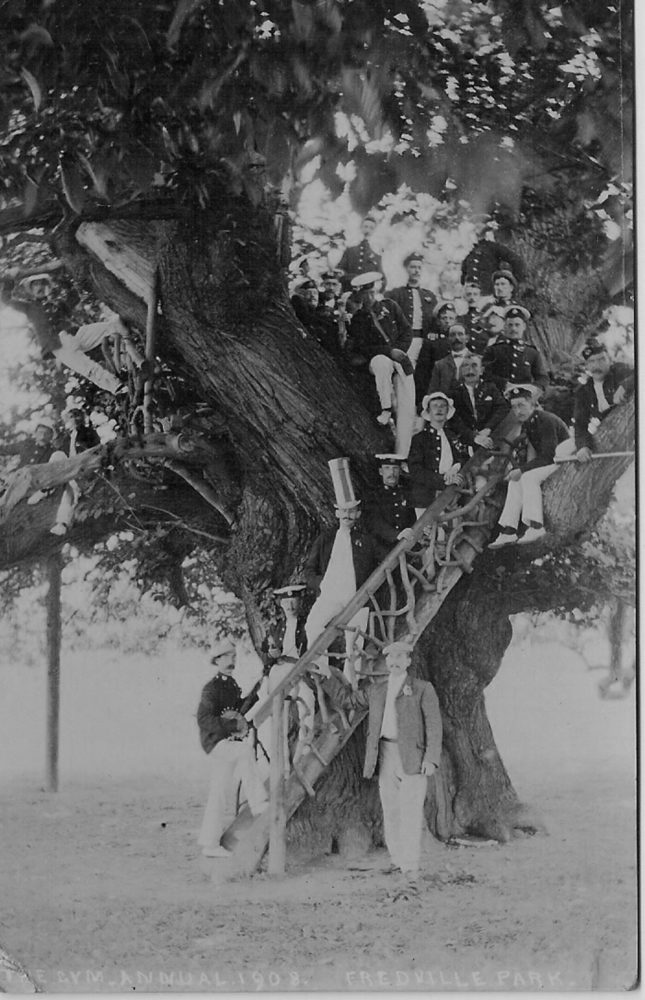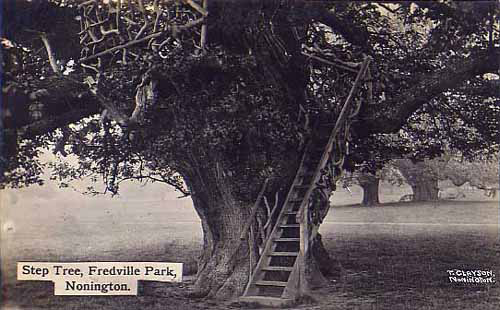In the 1930’s Dr. Hardman, a noted East Kent historian recorded the memories of Richard Jarvis Arnold of of life in Nonington in the 1880’s & 90’s. Mr. Arnold, a blacksmith born in Nonington but who later lived and worked in Walmer, recollected: “The trees of Fredville Park were well known. In addition to the old oak there were some large chestnuts. One was called the ‘Step Tree’ and had some steps affixed to it. In the upper part of the trunk and branches 12 or 20 people could sit”.
It was said that members of the Plumptre family often had tea on the platform in the “Step Tree” in the years before the Great War. The chestnut tree is still there but is now unfortunately showing its age, it is one of the few surviving sweet chestnut trees that once made up two avenues leading from Fredville House into the park.
After the new Fredville House was built by Margaretta Bridges, the sister of Sir Brooke Bridges of Goodnestone, in the 1740’s the farmland in front of the eastward facing house was landscaped after the fashion of the times. Two double rows of Spanish chestnut trees, also known as sweet chestnuts, were planted to form avenues leading from the new mansion into the landscaped parkland. The avenues ran eastward down into the parkland from the south [Frogham] and north [Nonington] ends of the mansion. Anyone then standing in the front door or looking through one of the front windows would have had an uninterrupted view down the avenue towards the top of the park.
John Evans in “The Juvenil Tourist: Or Excussion Through Various Parts of the Island of Great Britain“, published in 1805, said of the house ““Fredville is neat and spacious—it has, together with the house, within these few years been not only enlarged but improved with taste and judgment. The Mansion, standing on a rising ground, has a handsome brick front, supported by six columns of the Corinthian order—the drawing-room- is truly elegant, and the library contains several thousand volumes, selected from the most approved ancient and modern authors. From the front of the house to the south, Barson [Barfreston] mills wave their swifts above the plantations, and on the north-west Nunnington mills [the Easole corn mill & feed mills] form a correspondent prospect. The swing suspended from the high branch of a towering oak—the rabbits skipping from hole to hole, formed among the fibres of the trees, and a rising family of hearty children seen amidst their innocent gambols constitute at once a piece of rural and delightful scenery. At the south-west end of the Mansion the Green-house has a pretty effect, displaying the skill of the Botanist whilst the industrious bees are observed conveying their plundered stores into glasses fixed within the windows of their abode, which in its turn is plundered to enrich the owner’s table! The gardens behind the house are encircled with a shrubbery, along which a green walk, defended by a light post and rail, presents us with a view of the surrounding country. The woods on the south [Broom Hill and Oxney Woods, the first is under the colliery tip, the view of the second is now obscured by the same tip],—the distant telegraph on the west [the Admiralty telegraph at Womenswold] , and the Isle of Thanet with Ramsgate harbour, &c. on the north-east, tend to enrich and diversify the prospect. The Bowling Green also hid among the trees—the laurelled-covered Ice-house, the sweet briar hedge and the weeping ash trees enhance the sensations of delight arising from the contemplation of this spot. In a word, should any thing be thought wanting, a stream of water would complete the situation”.
The programme for an excursion by Kent Archaeological Society to Nonington in September, 1936, noted that: ‘The well known ‘Majesty

















Thank you for the information regarding the photographer.
I’m glad that the information was helpful.
It was taken by a photographer called Squier of Nonington and Sandwich
Thank you for all the information provided here. I was trying to find out more about the “Step Tree” as I have a postcard of it dated 1912? It is the same picture that you have above of the 3 children on the steps (including the 2 girls in white pinafores. The card was sent to a Dover address.